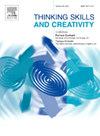Opening doors: To cognitively curate creativity concepts in art education
IF 3.7
2区 教育学
Q1 Social Sciences
引用次数: 0
Abstract
In this personal artographic inquiry paper, artistic engagements with doors and reflexive insights (of the artist, teacher, and researcher) help establish cognitive curation as a pedagogy and practice. In art education, practicing cognitive curation and cognitive curatorial pedagogy affords educators and learners critic, empathy, and autonomy in creative knowledge pursuits. When artography is used to cognitively curate doors open, as knowledge, which can transform understandings and systems. By demonstrating cognitive curations reflectively in curatorial pedagogy (applied during an M-Level Creativity and Visual Arts Education module), this paper opens five doors: navigating difference, accepting movement, engendering possibilities, building partnerships, and mobilizing knowledge complexities that could facilitate cognitive curation and cognitive curatorial pedagogy. By using artography to unravel the practice and pedagogy of cognitive curation, in this inquiry when teaching about creativity concepts, this paper responds to neoliberal art education barriers. It begins to show that using cognitive curatorial pedagogy could help curate and create autonomous, empathetic selves with permission to feel during creative educational experiences. Thus, using cognitive curation to bring forth and reinstate the intrinsic value of art education needed in global education systems.
打开大门:认知地策划艺术教育中的创意概念
在这篇个人艺术探究论文中,与门的艺术接触和(艺术家、教师和研究人员的)反思性见解有助于将认知策展作为一种教学法和实践。在艺术教育中,实践认知策展和认知策展教学法为教育者和学习者提供了创造性知识追求的批判、同理心和自主性。当艺术被用于认知策展时,门就像知识一样打开了,它可以改变理解和系统。通过在策展教育学中反思性地展示认知策展(在m级创造力和视觉艺术教育模块中应用),本文打开了五扇门:导航差异,接受运动,产生可能性,建立伙伴关系,以及调动知识复杂性,从而促进认知策展和认知策展教育学。本文通过运用艺术来揭示认知策展的实践与教学法,在探究创意概念教学时,回应新自由主义艺术教育的障碍。它开始表明,使用认知策展教学法可以帮助策展和创造自主的、有同理心的自我,并允许在创造性教育体验中感受。因此,用认知策展来提出并恢复全球教育体系所需要的艺术教育的内在价值。
本文章由计算机程序翻译,如有差异,请以英文原文为准。
求助全文
约1分钟内获得全文
求助全文
来源期刊

Thinking Skills and Creativity
EDUCATION & EDUCATIONAL RESEARCH-
CiteScore
6.40
自引率
16.20%
发文量
172
审稿时长
76 days
期刊介绍:
Thinking Skills and Creativity is a new journal providing a peer-reviewed forum for communication and debate for the community of researchers interested in teaching for thinking and creativity. Papers may represent a variety of theoretical perspectives and methodological approaches and may relate to any age level in a diversity of settings: formal and informal, education and work-based.
 求助内容:
求助内容: 应助结果提醒方式:
应助结果提醒方式:


